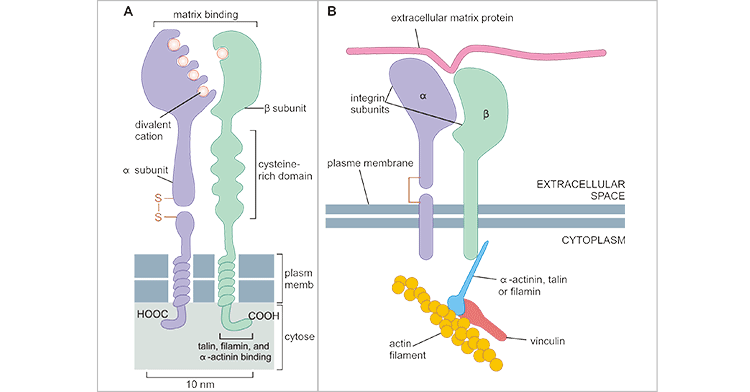Cell Adhesion
Cell adhesion is a dynamic process that plays an integral role in cell communication and regulation. Cell adhesion is the ability of a single cell to stick to another cell or or some other inanimate surface (such as an extracellular matrix (ECM)). It is important to understand how cells interact and coordinate their behavior in multicellular organisms [1]. It plays important roles during many normal physiological processes such as embryonic development and wound repair, and also during the progression of diseases such as cancer [2].
To accomplish this binding, cell adhesion molecules(CAMs) serve as intermediates that hold the cell to another surface. Adhesion molecules are generally divided into five groups: integrins, selectins, cadherins, members of the immunoglobulin superfamily (IgSF) and others such as mucins [3].
1. Integrins and Cell Adhesion
Integrins are crucially important heterodimeric cell surface receptors ensuring the mechanical connection between cells and the extracellular matrix [4]. An integrin molecule consists of two noncovalently associated transmembrane glycoprotein subunits called α and β. This molecule has a certain tissue specificity, that is the same integrin molecule in different cell types can have different ligand-binding specificities. it seems that additional cell-type-specific factors can interact with integrins to modulate their binding activity (Figure 1). In addition to the anchorage of cells to the extracellular matrix, these receptors have critical functions in intracellular signaling, but are also taking center stage in many physiological and pathological conditions.
Figure 1. The diagram of the structure of integrin
2. Selectins and Cell Adhesion
Selectins are another type of calcium-dependent cell adhesion molecules that consist of an N-terminal calcium-dependent lectin type domain, an EGF-like domain, and variable numbers of short repeats homologous to complement-binding sequences. These adhesion molecules are found on various immune cells and the endothelial cells, and allow cell-cell interactions within the bloodstream. L-selectin widely exists on the surface of various leukocytes, and participates in the process of leukocytes exiting the vessel at the verification site; E-selectin exists on the surface of activated vascular endothelial cells. P-selectin is stored in alpha granules of platelets and Weibel-Palade bodies of endothelial cells. P-selectin appears first on the surface of activated endothelial cells during inflammation, followed by E-selectin. They play an important role in recruiting white blood cells to the site of inflammation.
3. Cadherins and Cell Adhesion
Cadherins are transmembrane proteins that mediate cell–cell adhesion in animals involved in the Ca2+-dependent cell-cell adhesion mechanism [5]. Cadherins can be divided into three subclasses, including E-cadherin, N-cadherin and P-cadherin. Although all subclasses are similar in molecular weight, Ca2+- and protease-sensitivity, each subclass is featured by a unique tissue distribution pattern and immunological specificity. Cadherins play a crucial role in cell-cell contact formation and stability [6].
4. Immunoglobulin Superfamily and Cell Adhesion
The IgSF is one of the largest and most diverse families of proteins in the body with over 765 members. Members of the IgSF include major histocompatibility complex class I and II molecules, proteins of the T cell receptor complex, virus receptors, and cell surface glycoproteins [7]. Adhesion molecules belonging to the immunoglobulin superfamily (Ig-SF) commonly play a central role in cell-cell adhesion, and a number of these molecules have been associated with cancer progression and a metastatic phenotype [8].
5. Most Popular Targets Involved in Cell Adhesion
CUSABIO lists partial popular targets related cell adhesion, click to see all the related molecules/targets and research reagents of them.
References
[1] Khalili AA, Ahmad MR. A Review of Cell Adhesion Studies for Biomedical and Biological Applications [J]. Int J Mol Sci. 2015; 16(8): 18149-18184.
[2] Akiyama SK. Integrins in cell adhesion and signaling [J]. Hum Cell. 1996 Sep;9(3):181-6.
[3] Samanta D, Almo SC. Nectin family of cell-adhesion molecules: structural and molecular aspects of function and specificity. Cell Mol Life Sci. 2015, 72:645–58.
[4] Bachmann M, Kukkurainen S, Hytönen VP, Wehrle-Haller B. Cell Adhesion by Integrins [J]. Physiol Rev. 2019, 99 (4): 1655-1699.
[5] Takeichi M. The cadherins: cell-cell adhesion molecules controlling animal morphogenesis [J]. Development. 1988, 102 (4): 639-55.
[6] Maître JL, Heisenberg CP. Three functions of cadherins in cell adhesion [J]. Curr Biol. 2013, 23 (14): R626-R633.
[7] Soroka V, Kasper C, Poulsen FM. Structural Biology of NCAM. Neurochemical Research [J]. 2008:1–12.
[8] Wai Wong C, Dye DE, Coombe DR. The role of immunoglobulin superfamily cell adhesion molecules in cancer metastasis [J]. Int J Cell Biol. 2012; 340-296.


